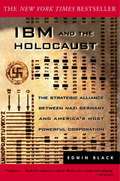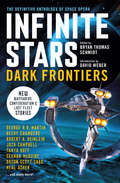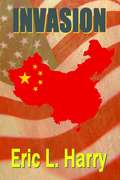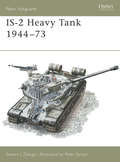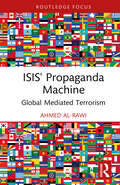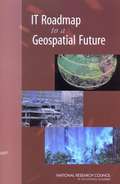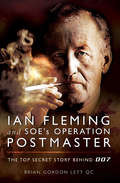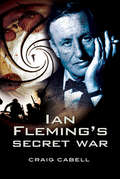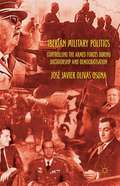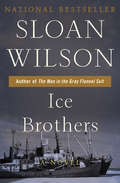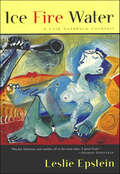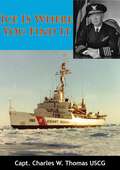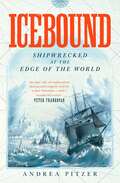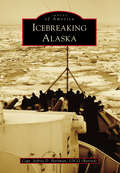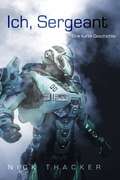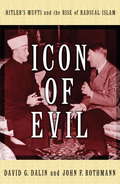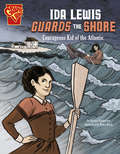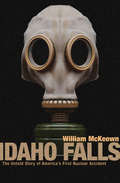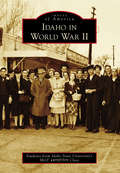- Table View
- List View
IBM and the Holocaust: The Strategic Alliance Between Nazi Germany and America's Most Powerful Corporation
by Edwin BlackNow in paperback, this is the shocking, impeccably researched, and incredibly detailed story of IBM's strategic alliance with Nazi Germany. Edwin Black's chilling investigation into corporate complicity in the atrocities raises startling questions and throws IBM's wartime ethics into serious doubt. Copyright © Libri GmbH. All rights reserved.
INFINITE STARS: DARK FRONTIERS
by Bryan Thomas SchmidtContinuing the definitive space opera anthology series. Today's most popular writers produce new stories in their most famous universes, alongside essential and seminal short fiction from past masters.The definitive collection of explorers and soldiers, charting the dark frontiers of our expanding universe. Amongst the infinite stars we find epic sagas of wars, tales of innermost humanity, and the most powerful of desires - our need to create a better world. The second volume of seminal short science fiction, featuring twenty-six new stories from series such as Wayfarers, Confederation, The Lost Fleet, Waypoint Kangaroo, Ender, Dream Park, the Polity and more.Alongside work from tomorrow's legends, revisit works by masters who helped define the genre: Arthur C. Clarke, Jack Campbell, Becky Chambers, Robert Heinlein, George R.R. Martin, Susan R. Matthews, Orson Scott Card, James Blish, E.E. "Doc" Smith, Tanya Huff, Curtis C. Chen, Seanan McGuire, Sharon Lee and Steve Miller, Larry Niven and Steven Barnes, Gardner Dozois, David Farland, Mike Shepherd, C.L. Moore, Neal Asher, Weston Ochse, Brenda Cooper, Alan Dean Foster, Kristine Kathryn Rusch, Kevin J. Anderson, David Weber and C.J. Cherryh.Infinite Stars: Dark Frontiers brings you the essential work from past, present, and future bestsellers as well as Grand Masters of science fiction.
INVASION
by Eric L HarryA powerful portrait of modern-day politics gone wild. U.S. Republican President Bill Baker is thrown a curveball when China puts its plan of world dominance into action. After invading Asian, European and finally Caribbean territory, it's obvious that four thousand miles of ocean is not enough to keep North America safe from China. The siege begins, and Baker retaliates by declaring war on China. As if this staggering situation weren't enough, Harry juxtaposes this scenario with the personal implications raised by the presence of the president's patriotic teenage daughter, Stephie Roberts, in the U.S. Army. Problems arise when Stephie's mother (the president's ex-wife) insists that her daughter be removed from danger--though not before Stephie's relationship with young Chinese army Lieutenant Wu surfaces...
INVASION
by Eric L HarryA powerful portrait of modern-day politics gone wild. U.S. Republican President Bill Baker is thrown a curveball when China puts its plan of world dominance into action. After invading Asian, European and finally Caribbean territory, it's obvious that four thousand miles of ocean is not enough to keep North America safe from China. The siege begins, and Baker retaliates by declaring war on China. As if this staggering situation weren't enough, Harry juxtaposes this scenario with the personal implications raised by the presence of the president's patriotic teenage daughter, Stephie Roberts, in the U.S. Army. Problems arise when Stephie's mother (the president's ex-wife) insists that her daughter be removed from danger--though not before Stephie's relationship with young Chinese army Lieutenant Wu surfaces...
IS-2 Heavy Tank 1944-73
by Steven Zaloga Peter SarsonThe Iosef Stalin tanks were the ultimate heavy tanks developed by the Soviet Union and were popularly called 'Victory tanks' due to their close association with the defeat of Germany in 1945. Yet in spite of their reputation, the Stalin tanks emerged from a troubled design, had a brief moment of glory in 1944 and 1945, and disappeared in ignominy after 1960. This title covers the events contributing to the Soviet Union's need to design the new series, with particular reference to the unsuccessful KV series and the advent of a new generation of heavy German tanks including the Tiger. It also covers their development, operational history and myriad variants. From the Trade Paperback edition.
ISIS' Propaganda Machine: Global Mediated Terrorism
by Ahmed Al-RawiThis book examines ISIS’ media propaganda machine.The book focuses on case studies that have been largely understudied in relation to ISIS’ media production. Empirically, it offers new insights into how ISIS uses its media production to disseminate its extremist ideology by focusing on video games, educational apps, Dark Web sites, and offline billboards. The book argues that despite all the discussion about how ISIS has disappeared or even died, the terrorist group’s daily activities on the Dark Web show that they are still thriving and disseminating their propaganda in more than 20 different languages, and effectively functioning as an international news organization. Using a mixed-method research approach, the book offers a multilayered understanding of media content and fills a major gap in the literature, especially in relation to the use of educational apps and the Dark Web.This book will be of much interest to students of media and communication studies, terrorism and counterterrorism, Middle Eastern politics, and international relations.
IT Roadmap to a Geospatial Future
by Information Technology Committee on Intersections Between Geospatial InformationThis report of the National Research Council examines the possibilities and promises of increased interaction between the geospatial and computer science research communities for capitalizing on the increasing complexity and diversity of georeferenced data. The goals of the report are to encourage the performance, accessibility, and usability of geospatial information; to identify how geospatial applications might influence computer science research; and to identify new geospatial applications made possible by recent advancements in computer science. Annotation ©2004 Book News, Inc. , Portland, OR (booknews. com)
Ian Fleming and SOE's Operation POSTMASTER: The Untold Top Secret Story
by Brian LettThe true story of the force of “licensed to kill” secret agents who became the basis for the James Bond spy series. Brigadier Colin Gubbins was M. The Special Operations Executive was his Secret Service. Professor Dudley Newitt was Q. Capt. Gus March-Phillips commanded “Maid of Honor Force,” the team of “James Bonds” who, in a daring operation, sailed a ship to West Africa and stole three enemy ships from a neutral Spanish port on the volcanic island of Fernando Po. Ian Fleming worked closely with M to oil the wheels that made the operation possible, and prepared the cover story, in which the British government lied in order to conceal British responsibility for the raid. M’s agents prepared the ground on Fernando Po, even enmeshing the governor in a honey trap. March-Phillips and his team carried out the raid successfully in January 1942, despite much opposition from the local regular Army and Navy commanders, and in the face of overwhelming odds. Foreign Secretary Anthony Eden told Fleming’s lies on the international stage, denying any British complicity in the operation. As a result, a secrecy embargo enveloped Operation POSTMASTER until recently. This gripping book proves beyond doubt that this thrilling operation, and the men who carried it out, were the inspiration for Fleming’s fictional 007.
Ian Fleming's Secret War
by Craig CabellWhile his extravagant and glamorous lifestyle is well known, little has been published concerning Ian Fleming's contribution during the Second World War. In the very early days of the War, Fleming was earmarked by the Director of Naval Intelligence as his 'right hand man'. From the outset he was in the center of events, meeting with key political and military figures as well as those of exceptional intelligence, experience and courage. All this was to give him invaluable background when he came to write the Bond novels. The author has uncovered through official documentation, private papers and contacts the depth of Fleming's work in Naval Intelligence. Fascinating insights of those he worked with and details of covert trips to Europe and North Africa emerge. Fleming was closely associated with 30 Assault Unit, a crack team of Commandos who took the fight to the enemy. The book reveals both the history of 30 AU and Fleming's role.
Iberian Military Politics: Controlling the Armed Forces during Dictatorship and Democratisation
by José Javier Olivas OsunaBy applying the nodality, authority, treasure and organisation public policy framework and neo-institutional theory to the dictatorship of Salazar and Franco respectively, this study explores the instruments that governments used to control the military and explains the divergent paths of civil-military relations in 20th Century Portugal and Spain.
Ice Brothers
by Sloan WilsonFollows a Coast Guard officer's adventures in Greenland during World War II.
Ice Brothers: A Novel
by Sloan WilsonThe bestselling World War II adventure story based on Sloan Wilson&’s experiences as a Coast Guard officer on the Greenland patrol After the attack on Pearl Harbor, Paul Schuman, a college senior and summer sailor, enlists in the Coast Guard. His beautiful, mercurial wife, Sylvia, wants him to stay at home in Massachusetts, but Paul is ready for adventure and eager to serve his country. His active duty begins when, without a day of training, he is assigned to be the executive officer aboard the Arluk, a converted fishing trawler patrolling the coast of Greenland for secret German weather bases. At the helm of the Arluk is Lt. Cdr. &“Mad&” Mowry, the finest ice pilot and meanest drunk in the Coast Guard. Paul has a lot to learn from his captain, but not as much as communications officer Nathan Greenberg does. A Brooklyn engineer, Nathan does not know the difference between a ship&’s bow and its stern. No matter how nasty Mowry might be, Schuman and Greenberg have to pay close attention, because deadly icebergs, dangerous blizzards, and menacing Nazi gunboats lurk along the frigid Arctic coastline. Surviving the war, Schuman soon realizes, will require every ounce of courage and intelligence he possesses—and that is before Mowry breaks down and the young officer is forced to take command of the Arluk and its crew at the worst possible moment. A masterful blend of high drama and convincing realism, Ice Brothers is a true classic of World War II and one of Sloan Wilson&’s finest novels.
Ice Fire Water: A Leib Goldkorn Cocktail
by Leslie Epstein"At once a travel tale, a historical meditation, a Holocaust revenge fantasy, and a bedroom farce."—D. T. Max, New York Times Book Review Leib Goldkorn, aged musician, first appeared almost a quarter-century ago in The Steinway Quintet. Now Leib has replaced his magic flute with his phallus: it is love, longing, and the quest for sexual fulfillment that must stave off both his own death and the imminent destruction of the Jews. In Ice he rescues the celebrated skater Sonja Henie from Hitler's clutches. In Fire his paramour is Carmen Miranda. And in Water he engages in a South Sea Island intrigue with a famous swimming star of the 1940s. Meanwhile, in the present, Leib seeks consummation with three other inamoratas: Clara, his wife; Hustler model Miss Crystal Knight; and the critic Michiko Kakutani (causing a real-life literary scandal). In this "wickedly funny" (Elle) and no less heartbreaking novel, Leib Goldkorn emerges as one of American literature's most enduring, and endearing, creations. A New York Times Notable Book; a Los Angeles Times Best Book of the Year.
Ice Is Where You Find It
by Capt. Charles W. Thomas USCG"You never can tell about ice--what it will be like--until you get there. Remember, ice is where you find it."Captain Thomas, whom Rear Admiral Richard E. Byrd has termed "one of the best ice sailors alive," was to recall his first lesson in polar navigation many times. He learned it the hard way when he was assigned to the command of the Coast Guard cutter Northland on wartime duty with the Greenland Patrol. Before 1943, though he was an experienced officer, he knew about ice only to the extent of grappling with the trays of his refrigerator! This was new business. Orders to hunt for Nazi weather stations meant combating a highly unpredictable foe, learning myriad tricks and a whole new jargon about compact fields, close pack, moderate pack, brash, floebergs, heaping ice, young ice, turret ice. The Northland's skipper was an "ice worm." Ice Is Where You Find It is a colorful account of six expeditions which, linked together, round out a full circle of an expert navigator's exciting experiences in the frozen waters of both the Arctic and the Antarctic Circles.The first missions were of great military importance despite the fact that there were only a handful of German scientists and technicians in the far North Atlantic area--needles in a vast frozen haystack.This is a book about versatile men who--regard-less of peace or war--match their wits with weather, spend rigorous lives in the interests of science, patriotism and humanitarianism, and get a kick out of it! The tougher the assignment, the greater the challenge to coastguardmen in whose vocabulary there is no word "can't."
Ice Station Nautilus (Trident Deception #3)
by Rick CampbellRussia's new ballistic missile submarine,Yuriy Dolgorukiy, is being deployed on its first patrol while America's newest fast attack submarine,North Dakota, is assigned to trail it and collect intel. As the Russian submarine heads under the polar ice cap, its sonar readings reveal the trailing American sub and cause the Russians to begin a radical, evasive maneuver. This, however, fails and the submarines collide, resulting in damage that sends both to the bottom. The Americans immediately set up a rescue mission, sending a new submarine and a SEAL team to establish an ice camp---Ice Station Nautilus---and stage a rescue. The Russians also send men and material, ostensibly to rescue their own men, but the Russian Special Forces team is also there to take the American base camp and the American sub, leaving no survivors or traces of their actions. As the men inNorth Dakota struggle to survive, the SEAL team battles for possession of the submarine. Rick Campbell's Ice Station Nautilus is an epic battle above and below the ice, Special Forces against SEALs, submarine against submarine, with survival on the line.
Ice Station Zebra
by Alistair MacLeanThe atomic submarine Dolphin has impossible orders: to sail beneath the ice-floes of the Arctic Ocean to locate and rescue the men of weather-station Zebra, gutted by fire and drifting with the ice-pack somewhere north of the Arctic Circle. But the orders do not say what the Dolphin will find if she succeeds -- that the fire at Ice Station Zebra was sabotage, and that one of the survivors is a killer!
Icebound: Shipwrecked At The Edge Of The World
by Andrea Pitzer'An epic tale of exploration, daring and tragedy told by a fine historian - and a wonderful writer' Peter Frankopan, author of the bestselling The Silk Roads. A dramatic and compelling account of survival against the odds from the golden Age of Exploration. Since its beginning, the human story has been one of exploration and survival - often against long odds. The longest odds of all might have been faced by Dutch explorer William Barents and his crew of fifteen, who on Barents&’ third journey into the Far Arctic in the year 1597 lost their ship to a crush of icebergs and, with few weapons and dwindling supplies, spent nine months fighting off ravenous polar bears, gnawing cold and seemingly endless winter. This is their story. In Icebound, Andrea Pitzer combines a movie-worthy tale of survival with a sweeping history of the period - a time of hope, adventure and seemingly unlimited scientific and geographic frontiers. At the story&’s centre is William Barents, one of the sixteenth century&’s greatest navigators, whose larger-than-life ambitions and obsessive quest to find a path through the deepest, most remote regions of the Arctic ended in both catastrophe and glory - glory because the desperation that his men endured had an epic quality that would echo through the centuries as both warning and spur to polar explorers. In a narrative that is filled with fascinating tutorials - on such topics as survival at twenty degrees below, the degeneration of the human body when it lacks Vitamin C, the history of mutiny, the practice of keel hauling, the art of celestial navigation and the intricacies of repairing masts and building shelters - the lesson that stands above all others is the feats humans are capable of when asked to double then triple then quadruple their physical capacities.
Icebreaking Alaska
by Capt. Jeffrey Hartman UscgThe Arctic is a place of great challenges and great rewards. A century ago, it was whale oil; today, it is motor oil. The increasing open water in the warmer months is attracting cruise ships to tour the Arctic. Significant offshore oil and natural gas deposits are of great interest to an oil-dependent economy. But the history of the Arctic is full of surprises for the unwary and the unprepared, despite native peoples having managed to live there for thousands of years. Oil spills or maritime emergencies can--and do--arise a long way off from assistance. Legendary Arctic storms are, if anything, becoming more intense and dangerous. All this is in an area inaccessible by roads or by sea except for icebreakers the majority of the year. It is of extreme interest to the US Coast Guard, charged with protecting seafarers, enforcing laws, and facilitating commerce.
Icehenge: A Novel
by Kim Stanley RobinsonSF titan Kim Stanley Robinson’s breakout novel, now in a Tor Essentials edition with a new introduction by Henry FarrellTor Essentials presents new editions of science fiction and fantasy titles of proven merit and lasting value, each volume introduced by an appropriate literary figure.Decades before his massively successful The Ministry for the Future (2020), Kim Stanley Robinson wrote one of SF’s greatest meditations on extended human lifespan, the limitations of human memory, and the haunted confabulations that go with forgetting.On the North Pole of Pluto there stands an enigma: a huge circle of standing blocks of ice, built on the pattern of Earth’s Stonehenge—but ten times the size, standing alone at the edge of the Solar System. What is it? Who could have built it?The secret lies in the chaotic decades of the Martian Revolution, in the lost memories of those who have lived for centuries.This new Tor Essentials edition of Icehenge includes a new introduction by Henry Farrell, co-author of Underground Empire: How America Weaponized the World Economy.At the Publisher's request, this title is being sold without Digital Rights Management Software (DRM) applied.
Icerigger (Gateway Essentials #299)
by Alan Dean FosterFar out on the frozen outer limits of the thranx/humanx Commonwealth, on the permafrosted plant of Tran-ky-ky, lay the chilly trading outpost of Brass Monkey.Inward bound on the interstellar transport Antares, Ethan Frome Fortune, space travelling salesman with a neat line in perfumes, jewelled knick-knacks and up market gadgetry, ran into grizzled, galactic hell raiser Skua September for the first time. Kidnapped, knocked unconscious and crash landed - all quite accidentally - they were about to find out that life on the sub- zero wasteland was full of incident. Bored they would not be. Dead they might well be - particularly if Sagyanak, Chief of the nomadic Horde, could lay hands on them. The great adventure has just begun and early retirement was not an option.
Ich, Sergeant
by Nick Thacker Christina Bergmann„Mein Name ist Renfro, Sergeant Renfro – oder einfach nur Sergeant …“ Ja, Sergeant ist mein Vorname und zufälligerweise auch mein Rang. Ich wurde in diesen Krieg, aber auch wegen dieses Krieges geboren ... doch das ist eine andere Geschichte. Mein Interesse für das Militär ging die meiste Zeit meines Lebens stark gegen Null, doch wie alle anderen meiner Generation wurde auch ich eingezogen. Der nächste Teil in Nick Thackers wachsender Sammlung von Sci-Fi-Action-/Abenteuer-Thrillern … Da ich den Krieg jedoch überleben wollte, kämpfte ich. Zuerst kämpfte ich, egoistisch wie ich war, nur um mein eigenes Leben, dann für das meiner Abteilung und Zuges, und schließlich für jeden Einzelnen, mit dem ich diente. Es war nicht gerade der einfachste Weg und vermutlich ziemlich egoistisch von mir, aber er hat mich hierher geführt. Freunde von Isaac Asimov und H.G. Wells, holt euch Ich, Sergeant noch heute!
Icon of Evil: Hitler's Mufti and the Rise of Radical Islam
by David G. Dalin John F. RothmannDalin (Hoover Institution, Stanford U. ) and Rothmann (Fromm Institute, U. of San Francisco) tell the story of Haj Amin al-Husseini, the one-time mufti of Jerusalem, and his support for the fascists during World War II. In the long-standing debate concerning whether Husseini's activities were driven by anti-Semitic hatred as opposed to anti-Zionism/Palestinian nationalism, they opt decisively for the former. Most of their discussion of Husseini's fascist activities will be relatively uncontroversial, although it's quite clear that when faced with choices of interpretation they are far more likely to chose the one that paints the mufti in a bad light, but their argument gets significantly weaker as they attempt to intimately connect Husseini to virtually every single opponent of the US and Israel in the Middle East including the Palestinian Liberation Organization, Saddam Hussein, Al-Qaeda, Hezbollah, and Hamas. Annotation ©2008 Book News, Inc. , Portland, OR (booknews. com)
Ida Lewis Guards the Shore: Courageous Kid of the Atlantic (Courageous Kids)
by Jessica GundersonIda Lewis spent a lifetime on the water, starting when her family moved the island of Lime Rock in 1857 for her father's job as lighthouse keeper. By age 15, Ida was the best swimmer in Newport, Rhode Island. And when her father suffers a stroke, Ida herself takes over as keeper of the lighthouse. But guarding the shore also means guarding the water. And when Ida spots four local boys in danger on the water, she knows she must take action, the boys' lives depend on it.
Idaho Falls: The Untold Story of America's First Nuclear Accident
by William McKeownThe little-known true story of a mysterious nuclear reactor disaster—years before Three Mile Island, Chernobyl, or Fukushima. Before the Three Mile Island incident or the Chernobyl disaster, the world&’s first nuclear reactor meltdown to claim lives happened on US soil. Chronicled here for the first time is the strange tale of SL-1, an experimental military reactor located in Idaho&’s Lost River Desert that exploded on the night of January 3, 1961, killing the three crewmembers on duty. Through exclusive interviews with the victims&’ families and friends, firsthand accounts from rescue workers and nuclear industry insiders, and extensive research into official documents, journalist William McKeown probes the many questions surrounding this devastating blast that have gone unanswered for decades. From reports of faulty design and mismanagement to incompetent personnel and even rumors of sabotage after a failed love affair, these plausible explanations raise startling new questions about whether the truth was deliberately suppressed to protect the nuclear energy industry.
Idaho in World War II (Images of America)
by Students from Idaho State University’s MGT 4499/5599 ClassAlthough far from the front lines of war, the people of Idaho contributed to the US effort in World War II in myriad ways. Entrepreneurs perfected the dehydration of potatoes and onions that became staples of the rations that sustained Allied troops stationed around the globe. Idahoans mined rare metals and manufactured them into weapons and munitions that allowed US forces to compete with the technologies of their opponents. Local communities organized USO huts that provided coffee, cookies, and warm smiles to homesick troops in transit to and from the war. However, World War II also left an indelible mark on the state of Idaho. On the one hand, the federal government's ambitious construction of airports, buildings, and roads to support the war effort transformed a rural state that had lacked infrastructure. On the other hand, Idaho soil housed detention camps where American citizens were denied fundamental rights. And loss and heartbreak impacted nearly every community.
